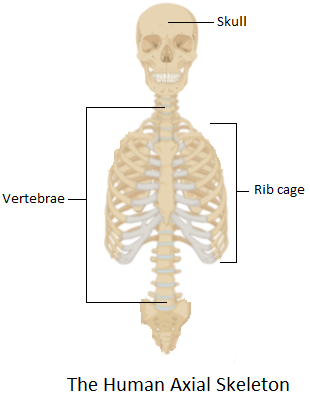
Total number of bones in the axial skeleton of a man is
A. 206
B. 120
C. 406
D. 80
Answer
556.2k+ views
Hint: The axial skeleton is one of the two parts of the whole human skeleton. It consists of the skull bones, the vertebral column, and the ribs. It acts to protect vital organs like the brain and the heart. The 28 skull bones, 26 vertebral bones, 24 ribs, a sternum, and a Hyoid bone make up the axial skeleton in man.
Complete answer: The axial skeleton is the uppermost part of the skeleton excluding the limbs. It is made up of the skull bones, the vertebral columns, and the ribs. It functions to protect the organs involved in digestion and breathing. The main function of the axial skeleton is to provide protection to the brain and the heart. Also, the axial skeleton plays a significant role in the movement of other bones.

The total number of bones in the axial skeleton of a man is 80. These bones consist of 28 skull bones, 26 vertebral columns, and 24 ribs. The bones in the skull, the vertebrae, and ribs are further classified based on their position and functions. The skull is made of 6 ossicles of the middle ear, 8 cranial bones, and 14 facial bones. 1 Hyoid bone is the additional skull bone. The vertebral column is made of 7 cervical vertebrae, 12 thoracic vertebrae, 5 lumbar vertebrae, 1 sacral region, and 1 coccyx. This makes a total of 26 bones of vertebrae. But sometimes when fused vertebrae are counted along with the vertebral columns the total number of vertebrae makes up to be 33 in number. The ribs are 24 in total with a thoracic cage consisting of 1 sternum. Hence, the total number of bones in the axial skeleton is 80 in number.
Therefore, the correct answer is option D.
Note: The ossicles of the middle ear consisting of the body’s three smallest bones have a major role in sound signal transfer. These are the malleus, incus, and stapes. These bones are responsible for transferring the vibrations produced by sound waves directly to the inner ear.
Complete answer: The axial skeleton is the uppermost part of the skeleton excluding the limbs. It is made up of the skull bones, the vertebral columns, and the ribs. It functions to protect the organs involved in digestion and breathing. The main function of the axial skeleton is to provide protection to the brain and the heart. Also, the axial skeleton plays a significant role in the movement of other bones.

The total number of bones in the axial skeleton of a man is 80. These bones consist of 28 skull bones, 26 vertebral columns, and 24 ribs. The bones in the skull, the vertebrae, and ribs are further classified based on their position and functions. The skull is made of 6 ossicles of the middle ear, 8 cranial bones, and 14 facial bones. 1 Hyoid bone is the additional skull bone. The vertebral column is made of 7 cervical vertebrae, 12 thoracic vertebrae, 5 lumbar vertebrae, 1 sacral region, and 1 coccyx. This makes a total of 26 bones of vertebrae. But sometimes when fused vertebrae are counted along with the vertebral columns the total number of vertebrae makes up to be 33 in number. The ribs are 24 in total with a thoracic cage consisting of 1 sternum. Hence, the total number of bones in the axial skeleton is 80 in number.
Therefore, the correct answer is option D.
Note: The ossicles of the middle ear consisting of the body’s three smallest bones have a major role in sound signal transfer. These are the malleus, incus, and stapes. These bones are responsible for transferring the vibrations produced by sound waves directly to the inner ear.
Recently Updated Pages
Why are manures considered better than fertilizers class 11 biology CBSE

Find the coordinates of the midpoint of the line segment class 11 maths CBSE

Distinguish between static friction limiting friction class 11 physics CBSE

The Chairman of the constituent Assembly was A Jawaharlal class 11 social science CBSE

The first National Commission on Labour NCL submitted class 11 social science CBSE

Number of all subshell of n + l 7 is A 4 B 5 C 6 D class 11 chemistry CBSE

Trending doubts
10 examples of friction in our daily life

One Metric ton is equal to kg A 10000 B 1000 C 100 class 11 physics CBSE

Difference Between Prokaryotic Cells and Eukaryotic Cells

1 Quintal is equal to a 110 kg b 10 kg c 100kg d 1000 class 11 physics CBSE

State the laws of reflection of light

Explain zero factorial class 11 maths CBSE




